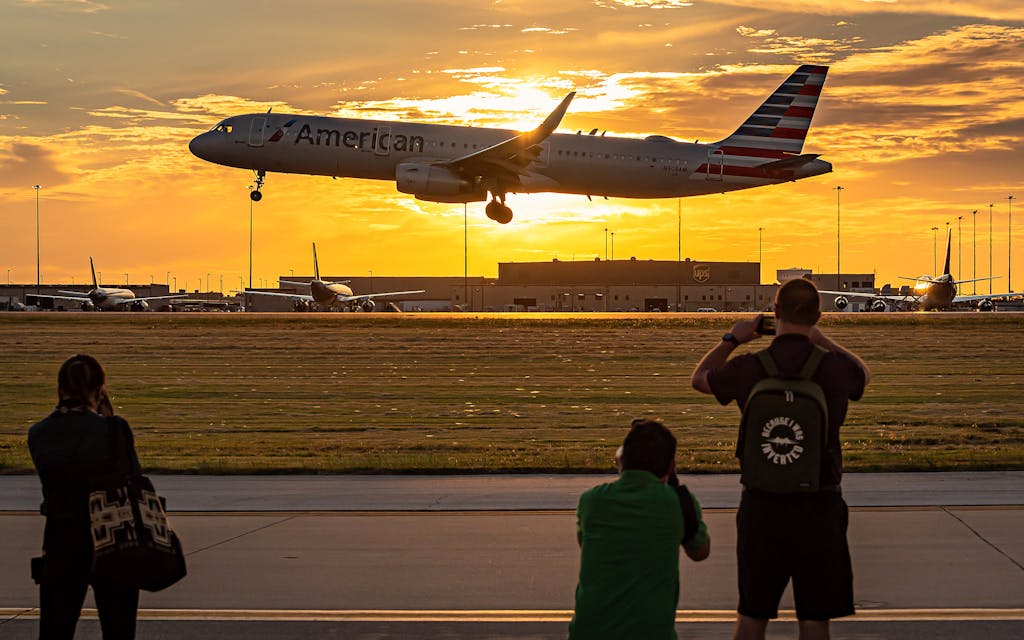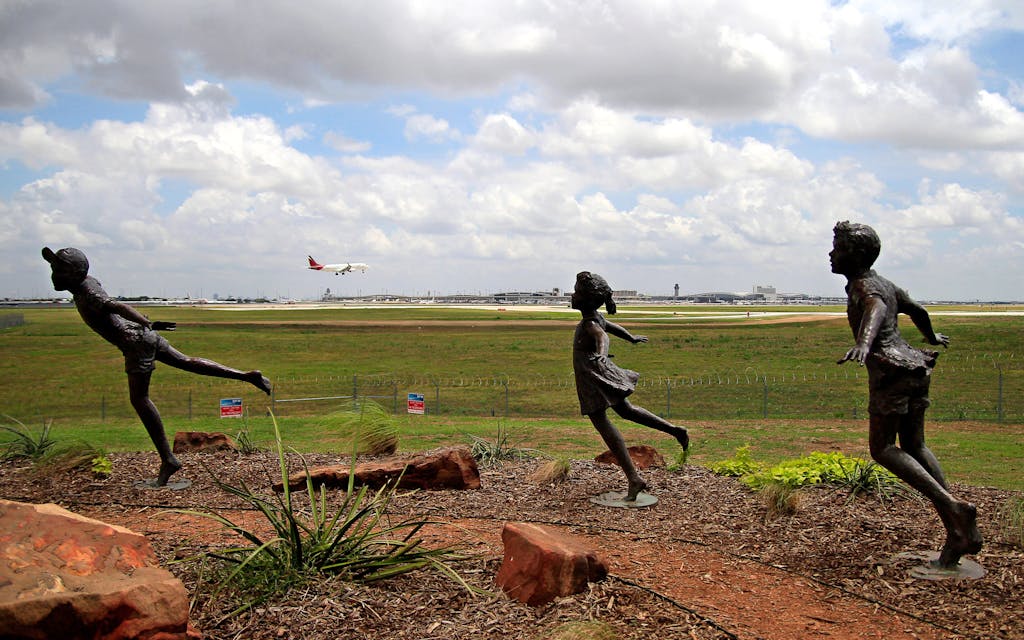[ad_1]
It’s the Fourth of July weekend and millions of Americans are traveling, but on the side of Texas Highway 114 and Airport Boulevard in Grapevine, scores of cars are parked. Hundreds of people have their eyes to the sky. The British are coming. British Airways, that is.
It has been 827 days since an Airbus A380, the world’s largest passenger plane, landed at Dallas–Fort Worth International Airport. On March 20, 2020, a Qantas A380 charged down the runway and didn’t make a return flight. International flights lacked passengers, so the superjumbo, which normally flies long-haul flights across the world, was parked on a tarmac God knows where. For more than a year, skies over DFW were relatively quiet. In May 2020, the airport helped transport 1.3 million passengers—79 percent fewer than the year before. This May, there were 6.6 million coming and going. Besides airline staff and travelers, that silence affected one lesser-known group: spotters.

Plane spotting is like birdwatching, except the birds are bigger than a house and much, much easier to spot. There are the heavies (an FAA designation for planes with a takeoff weight of more than 255,000 pounds), planes sporting unique livery (paint or design like Southwest’s famous Shamu), and government-issued ones (what Maverick flies). For a spotter, getting a glimpse of a new plane—or even better, taking a clear photo of one—is like finding a new baseball card. But unlike the hobbyists who collect Star Wars memorabilia or cocktail shakers, aviation geeks are interested in the intangible. When a plane comes into view, the experience lasts only a short time—about three minutes from first glimpse to wheels on the ground. Then you’re left with just the memory of, say, the first time you saw a Dreamliner land in Texas after taking off in Istanbul. If you’re lucky, you’ve snagged a photo to remember it. Then you get to brag about it on Facebook and Instagram, where spotters congregate in groups with names such as “The Plane Spot.”
“Airplane dorks are the biggest group of random folks you will ever see—everyone from pilots to engineers to plumbers and everything in between,” said spotter Brolin McKay. “People from all walks of life will stop what they’re doing because they see a plane.”
Today marks the roaring return of the heaviest of the heavies, and I get to see it up close. The airport’s social media team had a contest for aviation lovers and chose two winners with the best plane-spotting stories to stand in the airfield and watch the arrival of British Airways flight 193 from London. (One person walked several miles up to the Castle of Ibiza to watch landings.) Nearly three hundred people entered.
It’s not the first time DFW has taken spotters onto the tarmac, and these events are something the airport hopes to do more of in the future, in part because the AV-loving community keeps social media engagement high. For plane spotters, who sometimes travel to see unusual planes that don’t fly into the Metroplex, what DFW is offering today is unique. JFK Airport has the TWA Hotel, where enthusiasts can watch takeoffs while floating in the pool; Miami International Airport has holes in the fence by the runways so photographers can train their lenses on the runway. But no other is like this—so close to the planes that you can wave at each pilot taxiing. Every single one waves back. I can’t help but feel the same kind of giddiness that I did when, as a kid, I would roll down the car window, pump my arm, and get a honk from an eighteen-wheeler driver in response.

Our escort is Josh Smith, an airfield operations officer with a purple and silver manicure and knee-high black leather boots. As he drives us around the apron, where planes are loaded and unloaded, I grip my notebook a little more tightly. He casually steers the SUV around aircraft that are coming and going all around us. We take a backroad—a strip of asphalt just wide enough for a car—between runways 18R and 18L and come to stop at a taxiway. Smith makes a call to shut down that connecting path so we don’t cause a mishap. (Which in this context, I can’t quite bring myself to acknowledge in the moment, means a plane crash.) A spotter himself, Smith rolls down his window and lifts his camera.
Smith has a Nikon. In the front seat, contest winner Keith Reeves of Austin holds a Canon. I know from my time at newspapers that photographers are loyal to one of two brands of camera, the same way Ford owners wouldn’t ever be seen in a Chevy. The same can be said of AV geeks. Smith points to his camera. “Boeing.” He shifts his finger toward Reeves’s—“Airbus.” The geeks might consider this blasphemy, but I don’t really see much difference between the two.
Reeves and Smith agree that the golden hour at the end of the day provides the best light for photos of planes, but a blue sky doesn’t make the greatest backdrop. The topography of some places, such as the San Francisco Bay Area, magnifies the beauty of the aircraft. Today, the towering cumulonimbus clouds will suffice. And if one of them can capture the smoke as the tires make impact, that’s frame-worthy.
As we watch a Turkish Airlines Dreamliner come in, Smith cheekily tells us to wave to the crowd behind us at Founders’ Plaza. It’s a viewing spot that the airport dedicated just outside the fence in 1995. Air traffic radio is broadcast in the park, where there are benches, telescopes, and usually plenty of parking. Today’s arrival has drawn an unexpected crowd, and police have shown up to manage it. When spotters get too close to the fence, officers, who perhaps are thrown off by the number of people there, send them back toward the parking lot.

For many of the spotters I talked with, the hobby is a family affair. Scott Harris, who used to be an avionics technician in the Navy, spent his childhood sitting near the end of the runway at Texarkana Regional Airport. After watching Braniff International Airways and Texas International planes take off, he and his sister would scour the fields around the runway for blackberries that his grandmother would turn into cobbler. For Tom Griffith, a fun night as a kid in the fifties was when his parents would take the family of six to Houston International Airport, now called Houston Hobby Airport, and watch planes come and go.
It’s not just older generations reliving childhood memories. New ones are being made. Brad Striegel and his family moved from Normal, Illinois, three years ago. Up there, he and his teenage sons watched trains almost daily. Down here, they watch planes. “It’s kind of like opening presents on Christmas,” Striegel said. “There’s always a surprise—a big plane, a special livery, even the once-in-a-while go-around when a plane aborts a landing.”
The Airbus A380 has some well-earned nicknames: Certified Choker. Superjumbo. Chonky. As a double-decker plane that can hold more than eight hundred passengers, it’s a floating hotel. Its wingspan is 262 feet, and when fully loaded it weighs 1.2 million pounds. It’s a wonder it even gets airborne. When flight 193 comes into view on the ten-mile final, it’s third in line to land. In the distance behind the other two, the plane looks a lot like the blue whale coming in to swallow Marlin and Dory in Finding Nemo.
It passes Founders’ Plaza first before gliding over the fence toward runway 18R. The crowd claps and cheers. As the landing gear touches the tarmac, it lets out one screech, then another. The aircraft screams past us even as it slows down. Six seconds pass and the smell hits us. Burnt rubber and jet fuel. The spotters around me seem to be stunned into one-word statements. “Beautiful.” “Huge.” At Founders’ Plaza, a sentence comes over the police radio. “All this for that?”
For me, my buoyant mood isn’t just because we are yards away from the biggest aircraft I’ve ever seen. As I look around, the excitement strikes a chord. In a culture ripped apart by differences, it’s refreshing to see a silly grin on an adult’s face just because of something as simple as the sight of a large plane. It’s not really about the planes for Striegel either. His boys don’t play catch anymore. When he asks them about school, the response is usually, “Eh, it’s fine.” But twice a month, he spends three hours watching planes with Connor, 17, and Tyler, 13. He is filled with pride when he sees the photos they take and shares in their excitement when a new plane flies in. But most of all, the time away from phones and video games opens up to actual conversation with his teens—a rare bird indeed.
[ad_2]
Source link

